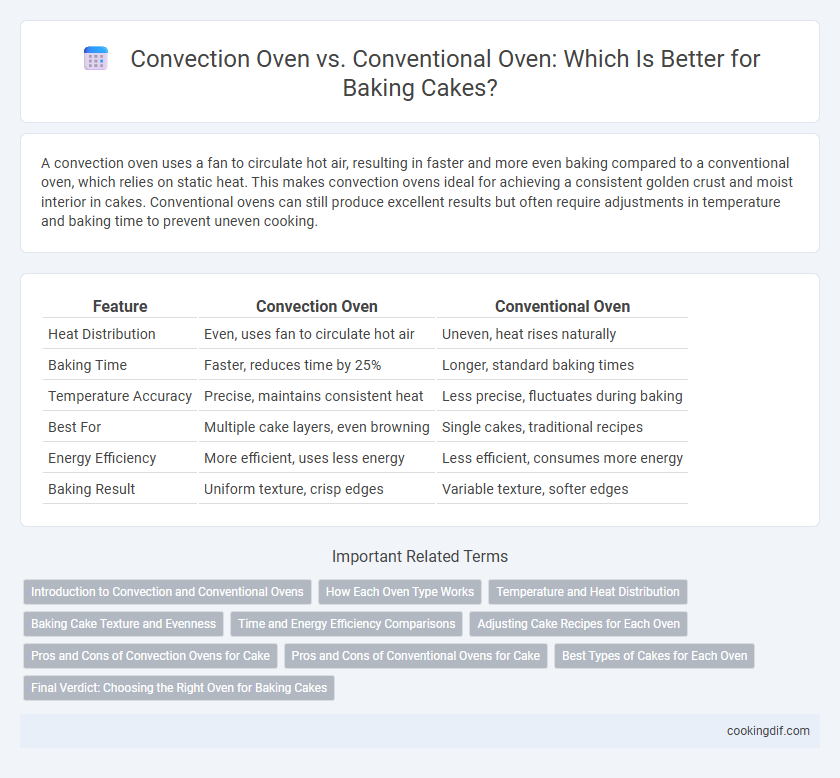A convection oven uses a fan to circulate hot air, resulting in faster and more even baking compared to a conventional oven, which relies on static heat. This makes convection ovens ideal for achieving a consistent golden crust and moist interior in cakes. Conventional ovens can still produce excellent results but often require adjustments in temperature and baking time to prevent uneven cooking.
Table of Comparison
| Feature | Convection Oven | Conventional Oven |
|---|---|---|
| Heat Distribution | Even, uses fan to circulate hot air | Uneven, heat rises naturally |
| Baking Time | Faster, reduces time by 25% | Longer, standard baking times |
| Temperature Accuracy | Precise, maintains consistent heat | Less precise, fluctuates during baking |
| Best For | Multiple cake layers, even browning | Single cakes, traditional recipes |
| Energy Efficiency | More efficient, uses less energy | Less efficient, consumes more energy |
| Baking Result | Uniform texture, crisp edges | Variable texture, softer edges |
Introduction to Convection and Conventional Ovens
Convection ovens feature a fan and exhaust system that circulate hot air around the food, promoting even baking and faster cooking times, ideal for achieving consistent cake textures. Conventional ovens rely on radiant heat from the oven walls, which can create hot spots and uneven baking but are preferred for traditional recipes requiring slower, gentle heat. Understanding the key differences in heat distribution and airflow is essential for selecting the best oven type for cake baking success.
How Each Oven Type Works
A convection oven uses a fan to circulate hot air evenly around the cake, promoting faster and more uniform baking by maintaining consistent temperatures throughout the oven cavity. In contrast, a conventional oven relies on radiant heat from the bottom or top heating elements, causing uneven heat distribution that can lead to hot spots and uneven cake rising. Understanding these mechanisms helps bakers choose the best oven type for detailed cake textures and precise baking outcomes.
Temperature and Heat Distribution
Convection ovens use a fan to circulate hot air, providing even heat distribution and maintaining a consistent temperature ideal for baking cakes evenly. Conventional ovens rely on radiant heat from the top and bottom, often resulting in uneven temperature zones that can cause cakes to bake unevenly or develop hot spots. Precise temperature control in convection ovens typically reduces baking time and prevents over-browning, enhancing cake texture and moisture retention.
Baking Cake Texture and Evenness
Convection ovens circulate hot air, promoting even heat distribution that results in cakes with uniform texture and consistent browning. Conventional ovens rely on radiant heat which can cause uneven cooking, often producing denser centers and slightly drier edges. For optimal cake texture and evenness, convection ovens usually offer superior results by minimizing hot spots and encouraging thorough baking.
Time and Energy Efficiency Comparisons
Convection ovens bake cakes faster by circulating hot air, reducing cooking time by up to 25% compared to conventional ovens. This efficiency lowers energy consumption, making convection ovens more cost-effective for frequent baking. Conventional ovens often require longer preheating and baking durations, leading to higher energy use.
Adjusting Cake Recipes for Each Oven
Adjusting cake recipes for convection ovens involves reducing the baking temperature by 25degF (about 15degC) and shortening the baking time by 25% due to the even heat circulation and faster cooking. Conventional ovens require consistent temperature and standard baking times, so recipes must maintain traditional settings to ensure proper cake rise and texture. Understanding each oven's heat dynamics is crucial for achieving optimal crumb structure and moisture retention in cakes.
Pros and Cons of Convection Ovens for Cake
Convection ovens circulate hot air with a fan, promoting even baking and faster cooking times, which can result in a lighter, more evenly browned cake crust. However, the fan may cause cakes to rise unevenly or form a tough exterior if temperature and baking times are not carefully adjusted. Conventional ovens provide gentler heat without airflow, reducing the risk of drying out delicate cake textures but often require longer baking times and may produce less uniform results.
Pros and Cons of Conventional Ovens for Cake
Conventional ovens provide consistent, radiant heat that creates a reliable environment for baking cakes, preserving moisture and tenderness. However, uneven heat distribution may cause hot spots, resulting in uneven rising or browning, which demands rotating pans during baking. Their simpler design compared to convection ovens often leads to slower cooking times and less energy efficiency.
Best Types of Cakes for Each Oven
Convection ovens excel in baking dense cakes like pound cakes and bundt cakes due to their even heat distribution and consistent air circulation, which ensures a uniform rise and moist crumb. Conventional ovens perform better for delicate cakes such as sponge cakes and chiffon cakes, where gentle, indirect heat helps maintain their light, airy texture and prevents over-browning. Choosing between convection and conventional ovens depends on the cake type, with denser recipes favoring convection and lighter cakes benefiting from conventional baking.
Final Verdict: Choosing the Right Oven for Baking Cakes
Convection ovens provide even heat distribution through a fan, resulting in faster, more uniform baking with a golden crust ideal for delicate cakes. Conventional ovens rely on radiant heat from the top and bottom, producing a gentler bake that maintains moisture but may cause uneven cooking. For bakers seeking consistent texture and quicker baking times, convection ovens are preferable, while conventional ovens suit recipes requiring slower, moist heat to preserve cake tenderness.
Convection oven vs Conventional oven for baking Infographic

 cookingdif.com
cookingdif.com